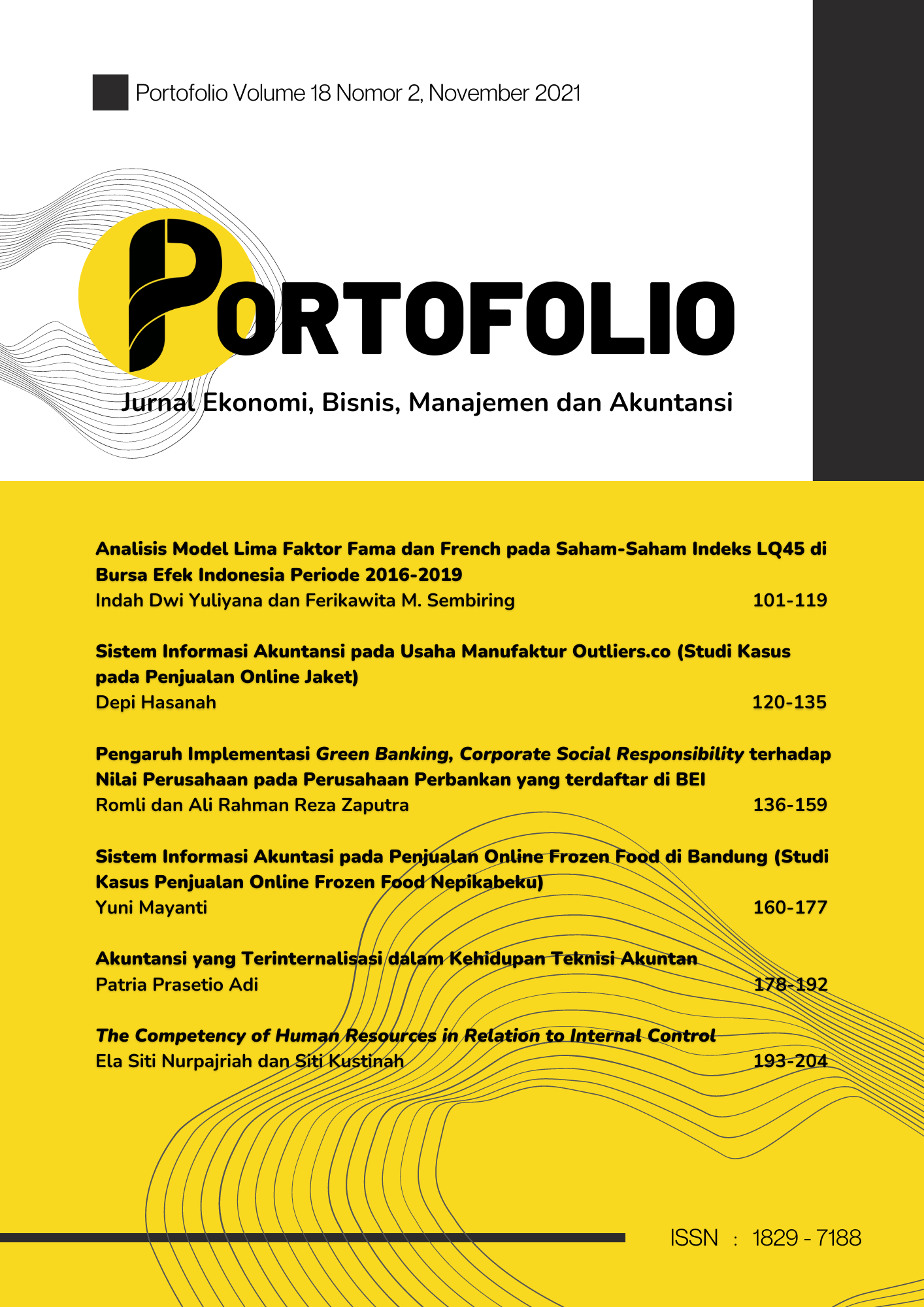Analisis Model Lima Faktor Fama dan French pada Saham-Saham Indeks LQ45 di Bursa Efek Indonesia Periode 2016-2019
Abstract
Abstract
The purpose of this research is to know the effect of Fama-French five factor model on LQ45 Index at Indonesia Stock Exchange during the period 2016-2019 in explaining portfolio returns in Indonesia either partially or simultaneously. The population in this study is all stocks that are included in the LQ45 Index and listed on the Indonesia Stock Exchange (BEI) during the period 2016-2019, which amounted to 60 companies. The sampling technique used was purposive sampling method which resulted in 22 companies selected as the research sample. The research method is associative quantitative research using panel data regression.
The research results partially are market factors, size (SMB), and value (HML) have a positive effect on excess returns. The profitability factor (RMW) has a negative effect on excess returns, and the investment factor (CMA) has not affect on excess portfolio returns. Simultaneously, the Fama-French five factor model can influence the excess returns.
Abstrak
Tujuan dari penelitian ini adalah untuk mengetahui pengaruh model lima faktor Fama dan French pada saham-saham Indeks LQ45 di Bursa Efek Indonesia periode 2016-2019 dalam menjelaskan return portofolio di Indonesia baik secara parsial maupun secara simultan. Populasi dalam penelitian ini adalah seluruh saham yang masuk ke dalam Indeks LQ45 dan tercatat di Bursa Efek Indonesia (BEI) periode 2016-2019 yang berjumlah sebanyak 60 perusahaan. Teknik sampling yang digunakan adalah metode purposive sampling yang menghasilkan 22 perusahaan yang terpilih menjadi sampel penelitian. Metode penelitian ini adalah penelitian kuantitatif asosiatif dengan menggunakan regresi data panel dalam pengolahan datanya. Hasil penelitian secara parsial yaitu faktor pasar, size (SMB), dan value (HML) berpengaruh positif terhadap excess return portofolio. Faktor profitabilitas (RMW) berpengaruh negatif terhadap excess return portofolio, dan faktor investasi (CMA) tidak berpengaruh terhadap excess return portofolio. Secara simultan kelima faktor Fama dan French berpengaruh terhadap excess return portofolio.
References
Candika, Y. I. (2017). Penguji Kekuatan Model Carhart Empat Faktor Terhadap Excess Return Saham di Indonesia. The Indonesian Journal of Applied Business.
Djamaluddin, S., & Rofii, A. (2017). Fama and French Five-Factors Pricing Model Testing in Indonesia. International Journal of Business and Management Invention ISSN, 6(9), 75–90. Retrieved from www.ijbmi.org75%7C
Fahrurrozi, M. R. (n.d.). Mengenal Indeks Harga Saham Lebih Dekat. Retrieved February 5, 2021, from https://www.poems.co.id/htm/Freeducation/LPNewsletter/v83/vol83_IndeksHargaSaham.html
Fama, E. F., & French, K. R. (2015). A five-factor asset pricing model. Journal of Financial Economics, 116(1), 1–22. https://doi.org/10.1016/j.jfineco.2014.10.010
Fama, F., & French, R. (1993). Common risk factors in the return’s stocks and bonds *. 33, 3–56.
Fitriani, E., Febrian, E., & Anwar, M. (2019). Analisis Three Factor Fama and French Model terhadap Return pada Indeks Saham Syariah Indonesia (ISSI) Periode 2011-2014. 3(2), 105–116.
Gumilar, I., Putra, S., Susanti, N., Putra, O. (2019). Pengujian Fama & French Five - Factors Asset Pricing Model Pendahuluan Jurnal Bisma. 13(3), 148–157.
Heriyandy, L. (2017). Analisis Penerapan Lima Faktor Model Fama & French di Indonesia. Jurnal Ilmiah, 5(2).
Huang, T. L. (2019). Is the Fama and French five-factor model robust in the Chinese stock market? Asia Pacific Management Review. https://doi.org/10.1016/j.apmrv.2018.10.002
Kevin, A. (n.d.). Sri Mulyani Ciptakan Fenomena Aneh di Pasar Saham, Apa Itu? CNBC Indonesia. Retrieved October 30, 2020, from https://www.cnbcindonesia.com/market/20191022105826-17-108925/sri-mulyani-ciptakan-fenomena-aneh-di-pasar-saham-apa-itu
Komara, E. F., & Yulianti, E. (2019). Analisis Perbandingan Capm Dengan Tfmff Dalam Mengestimasi Return Saham Pada Jii Periode 2014-2016. Jurnal Manajerial, 18(1), 41–53. https://doi.org/10.17509/manajerial.v18i1.16297
Melani, A. (n.d.). Melihat Kinerja Saham Paling Aktif di Pasar Modal Indonesia. Liputan6.Com. Retrieved October 30, 2020, from https://www.liputan6.com/bisnis/read/2641859/melihat-kinerja-saham-paling-aktif-di-pasar-modal-indonesia
Munawaroh, U., & Sunarsih, &. (2020). The effects of Fama-French five factor and momentum factor on Islamic stock portfolio excess return listed in ISSI. 6(2), 119–133. https://doi.org/10.20885/JEKI.vol6.iss2.art4
Saleh, M. (2020). Empirical Testing of the Five-Factor Model of Fama and French in Indonesia as an Emerging Capital Market. Journal of Economics and Business, 3(1). https://doi.org/10.31014/aior.1992.03.01.175
Sembiring, F. M. (2018). Three-Factor and Five-Factor Models: Implementation of Fama and French Model on Market Overreaction Conditions. Journal of Finance and Banking Review, 3(4), 77–83.
Sembiring, F. M., & Komara, E. F. (2020). Analisis CAPM Serta Model Multifaktor Fama & French pada Perusahaan Non Keuangan di Bursa Efek Indonesia. 4(2), 184–196.
Subekti, I., & Kusuma, I. (2001). Asosiasi antara Set Kesempatan Investasi dengan Kebijakan Pendanaan dan Dividen Perusahaan, serta Implikasinya pada Perubahan Harga Saham. Riset Akuntansi Indonesia.
Tandelilin, E. (2017). Pasar Modal: Manajemen Portofolio & Investasi. In Yogyakarta: Konisius.
Wijaya, S. C., & Murhadi, W. R. (2015). Analisis Fama French Five Factor Model dan Three Factor Model Dalam Menjelaskan Return Portofolio Saham.
Authors who publish in Portfolio: Jurnal Ekonomi, Bisnis, Manajemen, dan Akuntansi agree to the following terms:
- Authors retain copyright and grant the journal right of first publication with the work simultaneously licensed under a Attribution-ShareAlike 4.0 International (CC BY-SA 4.0) License that allows others to share the work with an acknowledgment of the work's authorship and initial publication in this journal.
- Authors are able to enter into separate, additional contractual arrangements for the non-exclusive distribution of the journal's published version of the work (e.g., post it to an institutional repository or publish it in a book), with an acknowledgment of its initial publication in this journal.
- Authors are permitted and encouraged to post their work online (e.g., in institutional repositories or on their website) prior to and during the submission process, as it can lead to productive exchanges, as well as earlier and greater citation of published work (See The Effect of Open Access).


1.png)






